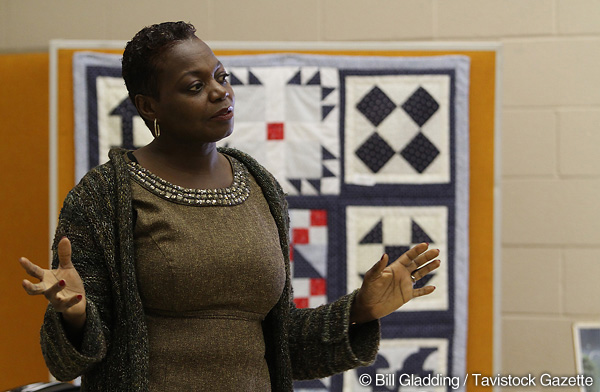Submitted by Admin on

from the Tavistock Gazette - Wednesday, April 2, 2014
Whenever she speaks, Marva Wisdom explains how she came to Canada from Jamaica in 1974 and her family settled in Tavistock. “I always talk about my roots,” she said. “and we have to own our story.”
Her story of immigration, however, is much different from the story she tells of the slaves who fled the United States to Canada in the mid 1800’s. As founding chair of the Guelph Black Heritage Foundation, her aim is to renovate an historic British Methodist Episcopal Church associated with the Underground Railroad of Southwestern Ontario.
As the guest speaker at the Tavistock and District Historical Society Annual General Meeting, Marva explained the focus of her work these days within the Foundation. The meeting was held in Grace United Church, Zion Hall, on Saturday, March 29, 2014.
“We’re always trying to figure out how we fit in,” she noted, and most of the time, “we’re forced to look at ourselves separately,” be it race, creed, or colour. But there were many dynamics at work during this time. Not only did slaves help slaves, but abolitionists, black and white, free and enslaved, worked alongside each other to aid the fugitives.
The Underground Railroad was a network of routes and safe houses leading slaves from the American south into Canada. If caught, runaway slaves would be returned to the plantations. Some crossed Detroit into Canada while others made their way across at Niagara Falls. Some secret code directions referred to the route as across the river Jordan from the black and into dawn. This meant to cross the River at Detroit during the night and arriving in Canada. Through songs and verse these people learned the way. To better guide them, a series of quilt blocks were also developed to assist in their journey. Each design had a special meaning and when hung on a clothesline, the fugitive would know the situation or the way to go.
A monkey wrench meant to pack your toolbox and prepare for a long journey. A log cabin quilt meant it was a safe house while a drunken sailor design suggested you stay off the trail. Flying geese or the north star indicated directions to follow.
Only recently did Marva find out the importance of aboriginals in assisting with the cause. She learned that the bear claw quilt suggested aboriginals would help guide. Their assistance was critical getting them through the woods and unpopulated areas.
Combining all these factors, it was the entire community that worked together to provide their freedom.
“These were people who wanted to make a difference,” she said.
While many black families populated the routes between the lakes from Niagara Falls through London and down to Sarnia, some came further inland and settled in the Guelph area. The British Methodist Episcopal Church in Guelph was a haven for the black community at a time when discrimination was prevalent. “Worship and religion were important things to them,” Marva explained. So, when that heritage building came up for sale, Marva was approached to lead the community in purchasing it, which they did in 2012. Since then, she has been creating awareness for the project as well as raising funds to create a meeting place and education centre which will pass on this rich area of Canadian history.
As an Historical Society, “what you do impacts generations to come,” she said. And you can honour people by listening to them and hearing their story. By building communities and groups, we offer everyone a sense of belonging. “And it’s only within that space that we find our common humanity,” she added.
Marva’s personal story began in Jamaica, the eldest of five children.
Her parents helped her achieve acceptance into high school where her teacher talked about visiting Canada one summer. Marva day-dreamed about living here one day but never shared the dream with her parents.
To her surprise, her mother announced that the family was moving to Canada. Her father kept animals and always wanted his own farm. They came to Tavistock thinking it was good farming country, but her father soon found out that farming in Canada was much different than in Jamaica. After about nine months they moved to Stratford where her parents still live.
While in Tavistock, Marva attended Waterloo-Oxford District Secondary School. She rode the bus with Kathy Rosenberg who attended Saturday’s meeting bringing along a yearbook from 1974-75 with Marva’s photo in it. Marva remembers the giant Afro haircut she spent hours perfecting. Her struggle to fit in here included buying blue jeans at the 5¢ to $1.00 store, a contrast from the crisp white uniforms she had been wearing in Jamaican schools. She also landed a job in the laundry at the Bonnie Brae nursing home.
That was her first Canadian experience and Marva has remembered the time fondly. Marva married Len Wisdom 31 years ago and the couple and their children live in Guelph. Her parents, Edward and Eva Bailey, and brothers Hainsley, Henroy and Andrew still live in Stratford. Sister Garvia Bailey is a broadcast journalist with CBC Radio in Toronto.
Following the presenta-tion, chair Brian Bennett gave an overview of the activities of the Historical Society for 2013. Sherrill Calder read the minutes of the 2013 annual meeting and treasurer Bob Rudy presented the 2013 annual financial report.
- 30 -